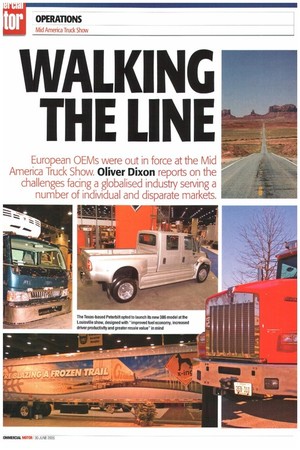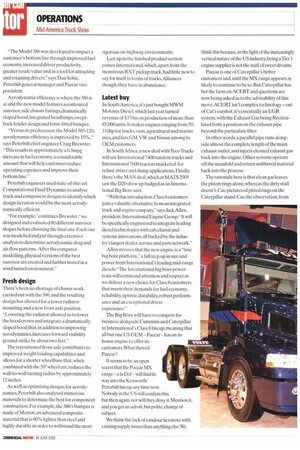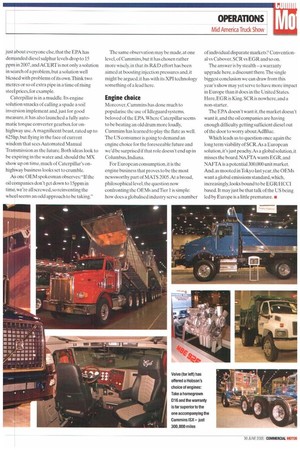WALKING THE I. NE
Page 64

Page 65

Page 66

Page 67

If you've noticed an error in this article please click here to report it so we can fix it.
European OEMs were out in force at the Mid
America Truck Show. Oliver Dixon reports on the
challenges facing a globalised industry serving a
number of individual and disparate markets. Time was when what happened truckwise in the United States was of interest only to those who happened to be in the US. The same could be said with equal justification of Europe and Japan.What happened away from your home region was of only passing interest to all but the most dedicated of industry watchers.
And then everything changed, and a new vocabulary emerged. In addition to talk of torque curves and diff ratios, commercial vehicle watchers began to converse about consolidation, alliances and scale.As a result, watching the neighbours became a global game.
And this,in tum,has developed into buying up the neighbours, with a situation in which the European OEMs now dominate the US and NAFTA markets. Except for Paccar, which owns Daf and Foden, and Navistar. now joined at the hip, if not the bank account, to MAN, every US-based OEM is owned by a European parent.
With the newly globalised OEMs pursuing scale with ever increasing vigour, the US market is. by extension, more important than ever to these European parents.But, NAFTA is a very individual place; the conventional is King, SCR is just three random letters and Euro-4 an America's Cup entry. In sum, the OEMs want to tie the whole lot together, while the customers are not unhappy with the way things stand.
And so to the Mid AmericaTruck Show, NAFTA's premier CV event and something of a challenge for the EU OEMs: namely how to provide a seemingly home grown product that fits into a global platform family.
More than any other rnanufacturer,Volvo has driven the idea of a common platform spanning the differing requirements of operators on both sides of the pond. MATS 2005 gave US truck buyers their first glimpse of the Swedish OEM's play for the high-end owner-operator market, with the unveiling of the VT880. At first glance, the VT880 is as American as pre-emptive defence. Available with output ratings up to 625hp, and with a sleeper compartment big enough to warrant its own zip code, the VT880 looks like a star-spangled beast.But on closer inspection, its heritage is skin deep at best.
new European parents. ey
Unimaginable choice
US operators expect choice at a level unthinkable to the verticalised European mindset.And US OEMs have traditionally taken those choices and bolted them together to form a truck.This approach is, understandably, anathema to the European truck building model, which likes to adopt a one size fits as many as possible approach. Leaving the question as to how best to serve both sides.
Volvo has played a cute hand here.
Yes, operators still get a choice of engine — either a Volvo D16 or a Cummins ISX — but then there is the small print; opt for the homegrown driveline and you get a three-year, 600,000 miles warranty. Opt for the Cummins, and the mileage cover drops to 300,000 miles. Some choice eh?
Volvo is pulling as much from its European product range as is possible, while still maintaining a conventional truck silhouette. Next up we are assured— off-the-record— is the introduc tion of I-Shift sometime early in 2007. Given that the back ends of both European and North American Volvo products sit on Arvin Mentor axles. this will mean a common driveline spanning the Atlantic.
And it's not just Volvo pursuing this approach. Freightliner, owned by DaimlerChrysler and the biggest player in the NAFTA heavy truck sector, also looks to be closing down on the choices, with Cunu-nins once again favoured as the non-proprietary engine. Here the point of interest is less to do with warranty and more to do with branding. Three years ago, finding a three-pointed star anywhere near a Freightliner product would have been well nigh unthinkable.Then they started to appear on the MBE engine range. Now, the logo "Powered by Mercedes-Benz" is beginning to show up on the trucks themselves.
Coming together
Add to this what appears to be aTelligent gear box and axles from the wholly-owned Axle Alliance Company in clear view on the Freightliner stand, and vertical integration seems to be gathering momentum in the Land of the Free. Consider, too, the recent relocation of the headquarters of DaimlerChrysler's two other US truck brands —Sterling and Western Star — to anew facility in Redford, Michigan, home of a new 300,000m2 Detroit Diesel plant as well as the aforementioned Axle Alliance Company, and what has been something of a disparate group is fast coming together. For reference, Freightliner has vehemently denied any plans to leave its existing Portland, Oregon, facility.
But vertical integration isn't an entirely new thing in the US. Mack has been following the approach for a while, with Mack engines working with Eaton boxes as a standard spec. The RVI-owned cousin of Volvo may now be looking with some interest at its Swedish sibling in terms of the D16 unit, especially as it's had a run of bad luck with turbo-chargers. Mack's display at MATS 2005 showed a lot of product, but we'd tend to regard it as a company where things are likely to happen in the future as opposed to one to get excited about right now.
You'd be hard pressed to adopt the same view of Paccar. In Europe, leaving aside a couple of lead time issues, Daf seems to be able to do no wrong. In the US, its Kenworth and Peterbilt ranges boast similar levels of customer satisfaction, andTexas-based Peterbilt opted to launch its new 386 model at the Louisville show. "The Model 386 was developed to impact a customer's bottom line through improved fuel economy, increased driver productivity, greater resale value and as a tool for attracting and retaining drivers," says Dan Sobic, Peterbilt general manager and Paccar vice president.
Aerodynamic efficiency is where the 386 is at and the new model features a contoured sunvisor, side chassis fairings, dramatically sloped hood, integrated headlamps, swept back fender design and form-fitted bumper.
"Versus its predecessor. the Model 385-120, aerodynamic efficiency is improved by 10%," says Peterbilt chief engineer Craig Brewster. "This results in approximately a 0.3mpg increase in fuel economy, a considerable amount that will help customers reduce operating expenses and improve their bottom line."
Peterbilt engineers used state-of-the-art Computational Fluid Dynamics to analyse truck and component designs to identify which design iteration would be the most aerodynamically efficient.
"For example," continues Brewster,"we designed and evaluated 80 different sunvisor shapes before choosing the final one. Each one was modelled and put through extensive analysis to determine aerodynamic drag and air-flow patterns. After the computer modelling, physical versions of the best sunvisor are created and further tested in a wind tunnel environment."
Fresh design
There's been no shortage of chassis work carried out with the 386, and the resulting design has allowed for a lower radiator mounting and a new front axle position. "Lowering the radiator allowed us to lower the hood crown and integrate a dramatically sloped hood that, in addition to improving aerodynamics, increases forward visibility ground-strike by about two feet" The repositioned front axle contributes to improved weight loading capabilities and allows for a shorter wheelbase that, when combined with the 500 wheel cut, reduces the wall-to-wall turning radius by approximately 12 inches.
As well as optimising designs for aerodynamics, Peterbilt also analysed numerous materials to determine the best for component onstruction , For example, the 386's bumper is made of Metton, an advanced composite material that is 60% lighter than steel and highly durable in order to withstand the most rigorous on-highway environments.
Last up in the finished product section comes International, which, apart from the monstrous RXT pickup truck, had little new to say for itself in terms of trucks.ALliances though, they have in abundance.
Latest buy
In South America,it's just bought MWM Motores Diesel, which last year turned revenue of $370m on production of more than 85,000 units. it makes engines ranging from 50310hp for trucks, vans, agricultural and marine uses, and lists GM,VW and Nissan among its OEM customers In South Africa, a new deal with Tyco Trucks will see International 7400 tandem trucks and International 7600 tractors marketed for refuse,mixer and dump applications Finally, there's the MAN deal, which at MATS 2005 saw the D20 show up badged as an International Big Bore unit.
"With this introduction,Class 8 customers gain a valuable alternative from an integrated truck and engine company," says Jack Allen, president,International Engine Group."It will be specifically engineered to integrate leading diesel technologies with cab, chassis and systems innovations, all backed by the industry's largest dealer, service and parts network."
Allen stresses that the new engine is a "true big bore platform," a full step up in size and power from international's leading mid-range diesels. "The international big bore powertrain will command attention and respect as we deliver a new choice for Class 8 customers that meets their demands for fuel economy, reliability, uptime. durability, robust performance and an exceptional driver experience."
The Big Bore will have to compete for business alongside Cummins and Caterpillar in International's Class 8 lineup, meaning that all but one US OEM — Paccar has an inhouse engine to offer its customers. What then of Paccar?
It seems to be an open secret that the Paccar MX range — a la Daf — will find its way into the Kenworth/ Peterbilt lineup any time now. Nobody in the US will confirm this, but then again, nor will they deny it. Mention it, and you get an adroit.but polite, change of subject.
We think this lack of candour lies more with existing supply issues than anything else. We think this because, in the light of the increasingly vertical nature of the US industry, being aTier 1 engine supplier is not the stuff of sweet dreams.
Paccar is one of Caterpillar's better customers and, until the MX range appears, is likely to continue to be so. But Caterpillar has bet the farm on ACERT and questions are now being asked as to the advisability of this move.ACERT isn't complex technology — out of Cat's earshot,it's essentially an EGR system, with the Exhaust Gas being Recirculated from a position on the exhaust pipe beyond the particulate filter.
In other words, a parallel pipe runs alongside almost the complete length of the main exhaust outlet, and injects cleaned exhaust gas back into the engine. Other systems operate off the manifold and return unfiltered material back into the process.
The rationale here is that clean gas leaves the piston rings alone, whereas the dirty stuff doesn't. Cue pictures of pitted rings on the Caterpillar stand. Cue the observation, from just about everyone else, that the EPA has demanded diesel sulphur levels drop to 15 ppm in 2007, and ACERT is not only a solution in search of a problem, but a solution well blessed with problems of its own.Think two metres or so of extra pipe in a time of rising steel prices, for example.
Caterpillar is in a muddle. Its engine solution smacks of calling a spade a soil inversion implement andjust for good measure, it has also launched a fully automatic torque converter gearbox for onhighway use. A magnificent beast, rated up to 625hp, but flying in the face of current wisdom that sees Automated Manual Transmission as the future. Both ideas look to be expiring in the water and, should the MX show up on time, much of Caterpillar's onhighway business looks set to crumble.
As one OEM spokesman observes: "If the oil companies don't get down to 15ppm in time, we're all screwed, so reinventing the wheel seems an odd approach to be taking," The same observation may be made, at one level, of Cummins, but it has chosen rather more wisely, in that its R&D effort has been aimed at boosting injection pressures and, it might be argued, it has with its )(PI technology something of a lead here.
Engine choice Moreover, Cummins has done much to popularise the use of Idleguard systems, beloved of the EPA. Where Caterpillar seems to be beating an old drum more loudly, Cummins has learned to play the flute as well. The US consumer is going to demand an engine choice for the foreseeable future and we'd be surprised if that role doesn't end up in Columbus, Indiana.
For European consumption,it is the engine business that proves to be the most newsworthy part of MATS 2005.At a broad, philosophical level, the question now confronting the OEMs andTier 1 is simple: how does a globalised industry serve a number of individual disparate markets? Conventional vs Cabover, SCR vs EGR and so on.
The answer is by stealth —a warranty upgrade here, a discount there.The single biggest conclusion we can draw from this year's show may yet serve to have more impact in Europe than it does in the United States, Here, EGR is King. SCR is nowhere, and a non-starter.
The EPA doesn't want it,the market doesn't want it, and the oil companies are having enough difficulty getting sufficient diesel out of the door to worry about AdBlue.
Which leads us to question once again the long term viability of SCR.As a European solution, it's just peachy. As a global solution, it misses the board. NAFTA wants EGR, and NAFTA is a potential 300,000 unit market. And. as mooted in Tokyo last year, the OEMs want a global emissions standard, which, increasingly, looks bound to be EGR/FICCI based. It mayjust be that talk of the US being led by Europe is a little premature. •


































































































































































































